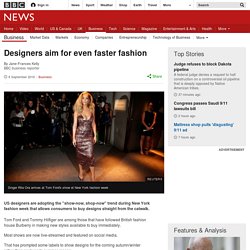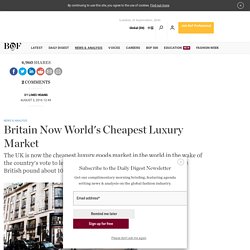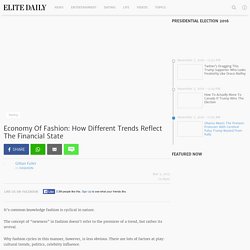

The rise of athleisure: how the high street is cashing in on office-to-gym wear. Designers aim for even faster fashion. Image copyright Reuters US designers are adopting the "show-now, shop-now" trend during New York fashion week that allows consumers to buy designs straight from the catwalk.

Tom Ford and Tommy Hilfiger are among those that have followed British fashion house Burberry in making new styles available to buy immediately. Most shows are now live-streamed and featured on social media. That has prompted some labels to show designs for the coming autumn/winter rather than next year's summer ranges. Not having to wait for glossy fashion magazines to feature the latest designs has helped to make consumers less content to accept delays of several months before they can buy them. Tom Ford is showing an autumn/winter 2016 collection for both men and women at New York fashion week rather than items for spring/summer next year.
Image copyright Getty Images Graeme Moran, head of content for fashion and features at Drapers magazine, said: "The whole industry is in flux. "I think it is very positive. A ‘Brexit’ Would Be Bad for Fashion. LONDON, United Kingdom — When the topic first began to trickle into parliamentary debate in early 2015, the notion of Britain exiting the European Union seemed absurd.

Indeed, if the idea of putting the matter to a direct public vote appeared unlikely, an actual “Brexit” seemed completely implausible. But 18 months later, with a national referendum just weeks away and public sentiment stirred up by an unprecedented migration crisis on top of the on-going European debt crisis, which has seen countries like Greece bailed out by the rest of the Eurozone, opinion polls on Brexit are much too close for comfort for British prime minister David Cameron, who has staked his political future on a “Remain” vote. From Bankruptcy to Billions: Fashion’s Greatest Second (and Third) Acts.
United Kingdom — In fashion, nothing is permanent.

Even when creative directors flee their posts or companies shutter their operations, opportunities for reinvention are often waiting just around the bend. Indeed, some of today's most successful fashion businesses went through years — and sometimes decades — of financial turmoil before achieving the level of global success they enjoy today. Rise: Gabrielle “Coco” Chanel opened her first store at 21 Rue Cambon in Paris in 1910. By the 1920s, the designer’s inimitable and thoroughly modern design point of view made her a fashion force. Her perfume, Chanel No. 5, which was introduced in 1921, made her a globally recognised icon. Breaking Point: In 1945, in the midst of World War II, Chanel was forced to shutter her couture house, although the company continued to produce fragrance and accessories. Rise: An icon of minimalism, Calvin Klein’s business was generating $30 million by 1977, just a decade after its founding.
Related Stories: Britain Now World's Cheapest Luxury Market. LONDON, United Kingdom — In the wake of Britain's vote to leave the EU, which pushed down the value of the pound about 10 percent against the euro, the country has become the cheapest luxury goods market in the world, helping to buoy British luxury labels, at least in the short term, according to new research by Luca Solca, the head of luxury goods at Exane BNP Paribas.

"The Brexit vote has made the UK the cheapest market in the world for luxury goods,” Solca told BoF. “A weak British pound will boost travel inflows to the UK, helping British luxury goods players like Burberry, Mulberry and Jimmy Choo. " While luxury goods companies are not expected to raise prices in the UK in the coming months — at least until there is more clarity around exactly when and how the country might exit the EU — Britain should see a boost from tourist inflows and spending due to its weakened currency.
Economy Of Fashion: How Different Trends Reflect The Financial State. It's common knowledge fashion is cyclical in nature.

The concept of “newness” in fashion doesn't refer to the premiere of a trend, but rather its revival. Why fashion cycles in this manner, however, is less obvious. There are lots of factors at play: cultural trends, politics, celebrity influence. One one of the most surprising factors to influence the cycle of fashion, though, is the state of the global economy. If you think about it, it makes sense. During tougher times, if you need new clothes, the focus is less on passing fads and more on classic, quality pieces worth the expenditure because they’ll last (which also aids in cutting down cost per wear).
As FIT professor John Mincarelli tells ABC News, “In rough economic times, people shop for replacement clothes,” adding “basics” prevail during an economic downturn. Economist George Taylor was the first to notice the correlation between fashion and the economy; he developed the “Hemline Theory” to describe his findings. Pinterest How?